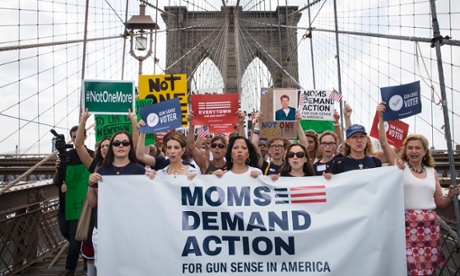
The tragedy of children killed accidentally by guns in the US is laid bare in new research that shows that as many as 100 boys and girls aged 14 and under are dying each year, substantially more than federal statistics have previously suggested.
Everytown and Moms Demand Action for Gun Sense in America - affiliated groups that campaign for stronger gun laws - have studied the incidents of publicly reported unintentional gun deaths involving children in the period of a year from 15 December 2012 to 14 December 2013. The report exposes a long list of lives cut short as a result of largely preventable calamities.
Like the one that befell two-year-old Sincere Smith in Conway, South Carolina, who was relaxing after a heavy meal of chicken and mac and cheese on Christmas day when he spotted an object on the living room table. It was a .38-caliber handgun that his father had bought two weeks before and had left on the table while he went to make a phone call. Sincere picked it up and fired a single shot through his own chest; he died en route to hospital.
Or that of Trinity Ross, aged four, who was playing with her six-year-old brother and another boy aged five at home in Kansas City, Missouri. While her stepmother was looking for something in the car outside the house, Trinity's brother discovered a revolver tucked under a jacket on a living room chair. He picked it up and pulled the trigger, accidentally hitting Trinity in the head; she died in hospital several days later.
Or Christopher Stanlane, aged 10, who was sitting on the floor at home in Fairmont, North Carolina, watching TV as his father was cleaning his shotgun on the couch beside him. The gun fired by mistake, hitting Christopher in the back of the head; he died instantly.
By the reckoning of Everytown and Moms Demand Action, such unbearable incidents are all too common - occurring at a rate of almost two a day across the US. The figure of 100 deaths the groups identified is substantially higher than the figure of 62 children recorded by federal authorities who die on average each year from unintentional gun incidents.
Shannon Watts, founder of Moms Demand Action, said historic underrepresentation of the problem underlined the lack of investment that was going into understanding and dealing with the crisis of child gun deaths. She blamed that in turn upon the influence of the National Rifle Association and the gun lobby which have applied sustained pressure on federal agencies to block research into accidental deaths involving firearms.
"We don't understand the problem of child gun deaths fully, and so we don't understand how we can prevent it. In this country we take the death of children very seriously - we have laws to prevent children getting stuck in freezers, or drowning in pools, yet we turn a blind eye when it comes to firearms. This is a national tragedy and it has to stop," she said.
The researchers found that some 70% of the deaths identified during the 12 months of the survey could have been prevented given simple measures to store and lock guns in the home unloaded. About a third of American children live in homes with guns - a product of the ubiquitous nature of weapons in society - and studies have suggested that 1.7 million kids live in homes with guns that are both loaded and unlocked.
Paradoxically, eight out of 10 of the deaths occurred in places where children are supposed to be coddled and safe: their homes or in homes of relatives, or in the family car. Basic childhood curiosity appears to have been behind many of the disasters, particularly of boys, with 77% of the victims and 82% of the shooters being male.
The ages of two to four, and 10 to 13 are particularly perilous in terms of gun deaths.
Two-thirds of the incidents involved guns that were legally owned by family members, usually a parent. In almost half of those cases, no charges were brought against the gun owner for negligence or other reckless behavior.
The report highlights other ways in which the NRA has been seminal in preventing the introduction of gun safety laws directed at children. It has lobbied vociferously against the recommendations of several professional bodies including the American Academy of Pediatrics that doctors should be allowed to advise patients about the importance of gun safety measures in the home.
The NRA has also opposed moves to introduce smart technology that only allow weapons to be fired by their biometrically-identified owners.
Moms Demand Action and Everytown want to see a number of reforms to improve safety for children. The proposals include the introduction at state level of laws that would penalize gun owners who fail to store their weapons responsibly; increased federal research into child gun deaths; funding for the development of smart technologies used in gun safety devices; and education schemes that include doctors to make parents more aware of the dangers.
"The lives of American children are precious, they matter. Legislators need to stand up and say, regardless of the efforts of the gun lobby to protect their profits, we are going to protect our children," Watts said.



Or is this article supporting stronger gun laws? You can't save everyone, Darwin has to come in play somewhere. I'm not a mathematician, but the numbers I see are less than 1% of the population here in America. Actually seems like a decent stat, less than 1% of the populations kids die accidently from a gun. I don't consider that bad. There are way worse stats out there causing true problems. 99% of politicians are corrupt, when will that be addressed? /rant off